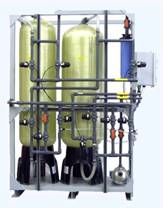|
Similar to the processes based on carbon adsorption,
ion exchange or chromatography, biosorption is based
on the sorption operation. In the process, the desired compound
is extracted from a mixed solution onto a solid phase of the
sorbent. The more specific the sorbent is the more effective
its application.
Most often, the process uses
a simple column packed with the active sorbent through which
flows the solution containing the target compound. The sorbent
inside the column gets gradually saturated with it. In a
separate run of the process, the deposited compound is
eventually released from the solid sorbent in a concentrated and
grossly purified form.
Just like living creatures,
technologies move along their 'growth curve' - eventually to
disappear and be replaced by the new ones.
“Bio” represents the contemporary science frontier. The
conventional physico-chemical process era of thermal separations
(e.g. distillation) provided the basis for petrochemical boom of
the past century. These technologies have matured and no new
breakthrough-based growth can be envisioned in that area.
As bio-compounds are
temperature sensitive and usually occur in aqueous solutions,
low temperature processing is mandatory in this sector.
Sorption and membrane based processes
provide the technological basis for the new era of biochemicals
and pharmaceuticals – as well as for more efficient and cost
effective environmental clean-up.
The knowledge and command of
sorption/biosorption techniques provide the technological
process basis for the whole new bio and environmental industry.
|
|
We have the leading know-how in this area, including exclusive
new family of high-performance biosorbents and their analogues.
We are experts in the sorption process and its applications.
|
 |
|
Biosorption in |

|
|
|
ENVIRONMENTAL |
applications |
|
|
Toxic or dangerous contaminants have to be removed from the
aqueous environment. Activated carbon or ion exchange resins
have long been used for this purpose. Specific biosorbents have
been prepared to extract toxic heavy metals (copper,
cadmium, lead, zinc, etc.) from solutions. They do so
effectively and at a fraction of the cost.
The demand for the treatment is dictated usually by the
government regulatory authorities.
Environmental clean-up is done when necessary and it is driven
by safety/health considerations.
In the biosorption process the metals of
value can also be recovered for recycle or re-sale. As the
biosorption operation uses simple and common sorption columns, its
applications are not only technically feasible but also economically
very attractive. |
|
| |
It is obvious, that
biosorption is here not only to remove toxic metals ....
There are other "hi-biotech" applications - |
|
|
Biosorption in |
|
|
PRODUCT PURIFICATION |
Pharmaceuticals ! |
|
Some chemical, biochemical compounds command extremely high
market price (e.g. pharmaceuticals at thousands of $$ per
gram). Their production often includes complicated and costly
recovery-purification procedures. Specific biosorbents can
recover these precious compounds from complex mixtures in a
one-step sorption operation - a dream of every engineer.
|
 |
|
The demand for
bio-products is
market / demand driven, their price and
availability often dependent on technological processes involved
in the recovery/purification – enabling technologies are crucial
for the supply.
Sorption operations also provide, in part, the backbone of new
generation of “green” and non-polluting technological processes.
|
|